When I decided to feature the World Series from 50, 75 and 100 years ago, I thought it was going to be one general post. It turned into five. Just too many good things that a retired lawyer can find with Google. So now for the finale. The 1967 World Series between the Cardinals and the Red Sox.
1967 National League Pennant: From 1964 to 1968, the St. Louis Cardinals won the NL pennant three times (’64, ’67 and ’68). All of the pennant teams included starters Tim McCarver (C), Julian Javier (2B), Lou Brock (LF), Curt Flood (CF) and Mike Shannon (RF/SS). The pitching staff was anchored by Bob Gibson. Added after 1964 were Orlando Cepeda (1B), Roger Maris (RF) and Steve Carlton(P). This made for a team of strong personalities that could either explode or bond. I’ll let Curt Flood explain how it worked out:
“…as close to being free of racist poison as a diverse group of twentieth-century Americans could possibly be. Few of them had been that way before they came to the Cardinals. But they changed…The initiative in building that spirit came from the black members of the team. Especially Bob Gibson…(W)e blacks wanted life to be more pleasant, championships or not…It began with Gibson and me deliberately kicking over traditional barriers to establish communication with the palefaces…After breaking bread and pouring a few with us, the others felt better about themselves and us. Actual friendships developed. Tim McCarver was a rugged white kid from Tennessee and we were black, black cats…Without imposing blackness on Tim or whiteness on ourselves, we simply insisted on knowing him and on being known in return.”
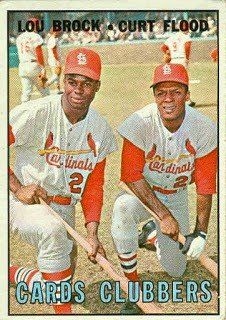
Gibson’s role was echoed by Tim McCarver in his memoir Oh, Baby, I Love It!, “I believe Bob taught me a good deal about relationships with other human beings. If I came to that first spring training with many of the preoccupations of my birthplace, it was probably Gibby more than any other black man who helped me to overcome whatever latent prejudices I may have had.”
In the 1967 pennant run, Gibson missed eight weeks with an injury (more on that below). His absence was mitigated by good seasons from several players. Six Cardinals finished in the top 20 of the MVP voting: Orlando Cepeda (unanimous winner), Tim McCarver (2), Lou Brock (7) and Curt Flood (13), plus two pitchers who stepped up with Gibson out, Nelson Briles (15) and Dick Hughes (17).
That was more than enough as the Cardinals ran away with the 1967 NL pennant, finishing 10.5 games ahead of the second place Giants.
1967 American League Pennant: Before 1967, the 1960’s had not been kind to the Boston Red Sox. They were in the second division each year, and in 1965 and 1966, they finished ninth out of ten teams. When they jumped from ninth to first in 1967, the season became known as the “Impossible Dream.” It was not an easy trip.
The American League was a 4-way race for most of the season among the White Sox, Tigers, Twins and Red Sox. The White Sox were eliminated in the last week. The other three teams entered the last day of the season in almost a dead heat. The Twins and Red Sox were 91-70 and were playing each other. The Tigers were 90-70 and playing a double header against the Angels. The Tigers started earlier and won the first game. At that stage, it was a 3-way tie at 91-70. The Angels beat the Tigers in the second game, and the Red Sox beat the Twins to take the pennant. With the race so close, the Twins had printed a “Dewey Defeats Truman” program for their potential Series:
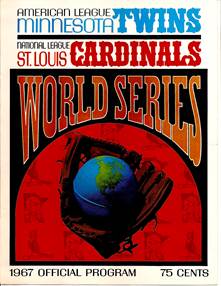
The Red Sox were led by Cy Young winner Jim Lonborg and MVP Carl Yastrzemski. Yaz won the Triple Crown and rose to the occasion for the close pennant race – he went seven-for-eight in the key two final games and hit .491 the last 17 days of the season. Others who had good seasons included George Scott, Elston Howard, Rico Petrocelli, and, until injured, Tony Conigliaro. The third baseman was Joe Foy who the Royals selected the following year in the expansion draft for their inaugural 1969 season.
Two Big Time Injuries: The matchup of the Red Sox and Cardinals followed a season where each team had been profoundly affected by a rocketing baseball between a pitcher and a batter.
For the Red Sox, it happened on a pitch by the Angels’ Jack Hamilton that hit their rising young star Tony Conigliaro. On July 23, Tony had hit his 100th career homer, the youngest ever to reach that level in the American League (he was 22; the record still stands). Tony was known to crowd the plate, and he had heard from a friend that Ted Williams thought it might be wise to back off. Ted’s message was delivered to Tony on August 17, but Tony declined the suggestion, saying that the pitchers wouldn’t take him seriously. The very next day, Hamilton’s pitch smashed Tony’s left cheekbone, dislocated his jaw and severely damaged his left retina.
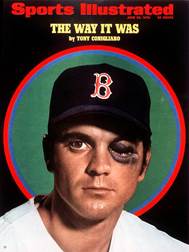
Tony missed the rest of the 1967 season and all of 1968. He was comeback player of the year in 1969 and appeared on the cover of Sports Illustrated in 1970, showing his damaged face from 1967. He had a couple of successful seasons, but never returned to his Hall of Fame potential.
The other speeding baseball came off the bat of Roberto Clemente who lined the ball so hard back at pitcher Bob Gibson that it broke Gibson’s leg. The trainer did not realize the leg was broken, and after some spray of ethyl chloride and taping, Gibson continued to pitch. He gave up a walk, got an out on pop-up, and then threw a fastball to the next hitter, landing hard and snapping his fibula in two.

Gibson was out from July 15 to September 7. He returned Just in time to get primed for the World Series.
1967 World Series – Boston Red Sox v. St. Louis Cardinals: First, a program showing the actual participants…
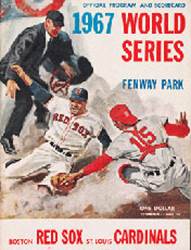
In the 1967 World Series, it was about the pitching. The aces were Bob Gibson of the Cards and Jim Lonborg of the Red Sox. But they did not pitch against each other until Game 7. Lonborg had been used to wrap up the Red Sox pennant in the last game of the regular season, and so he was held back until Game 2. Here is how it played out:
Game 1 – Gibson won 2-1.
Game 2 – Lonborg pitched a 5-0 shutout. Yastrzemski hit two homers to knock in four of the runs.
Game 3 – Nelson Briles pitched a gem for the Cardinals, winning 5-2.
Game 4 – Gibson won again, this time a 6-0 shutout.
Game 5 – Lonborg won again, 3-1.
Game 6 – The only game not dominated by a pitcher. Cards starter Dick Hughes was knocked out after giving up three homers in the 4th inning. Red Sox rookie Gary Waslewski pitched well and left in the 6th with a 4-2 lead. The Cards tied the game in the top of the 7th with two runs off Red Sox reliever John Wyatt. Boston came back in the bottom of the 7th to score four on their way to an 8-4 victory.
[John Wyatt Trivia: John pitched for our Kansas City A’s from 1961 to 1966. He played from 1953 to 1955 for the Indianapolis Clowns in the Negro Leagues, but for part of 1954 played minor league ball for the Cardinals. His next connection to the Cardinals was pitching against them in this Game 6.]
Game 7 – Finally, the aces Longborg v. Gibson faced each other. Lonborg had one less day of rest and it showed. Gibson pitched another gem and also hit a home run. The Cardinals won the game (7-2) and the Series (4-3).
Gibson’s Series ERA was 1.00, and his three complete game victories made him the MVP. His broken leg during the season had a silver lining – he was well rested for the Series.
Although pitching was the big story of the Series, the Cards got strong efforts on offense from Lou Brock (.414), Roger Maris (.385) and Julian Javiar (.360). For the Red Sox, Carl Yastrzemski continued his MVP season pace, batting .400 and hitting three homers. Lou Brock stole seven bases; all other players had an aggregate total of one. His seven stolen bases remains the record for a Series and has been tied only one other time – by Lou Brock in 1968.
Bob Gibson – Mr. Competitor: Gibson was legendary for his competitiveness, and his World Series appearances provided some of the best evidence. He made it to the Series three times – 1964, 1967 and 1968. He pitched three games in each, compiling a 7-2 record. He lost his first in 1964, but then won the next seven. He lost his last game (Game 7 in 1968) when Curt Flood misjudged a line drive to allow the winning runs that gave the Tigers the championship. Gibson was MVP in the 1964 and 1967 Series. He holds the game strikeout record of 17 (Game 1 in 1968). He has the most consecutive wins (7) and consecutive complete games (8). He had 92 strikeouts in 81 innings. The only pitcher with more is Whitey Ford – 94 in 146 innings.
I like this Tim McCarver quote about his friend “Hoot” Gibson: “For my money, the most intimidating, arrogant pitcher ever to kick up dirt on a mound is Bob Gibson…you’d never forget his style: his cap pulled down low over his eyes, the ball gripped – almost mashed – behind his right hip, the eyes smoldering at each batter almost accusingly. That was how Hoot looked out there before his right arm went to work. Restless as an imprisoned cougar, Hoot would then unwind, and the ball would accelerate faster than a runaway locomotive. He didn’t like to lose to anyone at anything.”
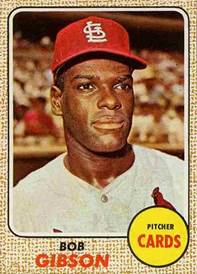
Gibson was also the key player in the “Year of the Pitcher” – 1968. Denny McClain of the Tigers won 31 games. Don Drysdale of the Dodgers pitched six consecutive shutouts, stringing together a record 58 straight innings of shutout ball. But Bob Gibson was even better. He had a stat that was one for the ages – a season ERA of 1.12. Not a typo. It is by far the lowest ERA in the live ball era (1920 and after). Next in line is Greg Maddux at 1.56 (1994). With the pitchers dominating the hitters in both leagues, the owners (and fans) wanted something done to create more runs. Cardinal sportswriter Bob Broeg felt it was Gibson’s own fault, telling him “Goddam it Gib, you’re changing the game. It isn’t fun anymore. You’re making it like hockey.”
Gibson’s role was addressed by Roger Angell in his famous 1980 New Yorker essay on Gibson: “Bob Gibson, we may conclude, was the man most responsible for the next major change in the dimensions of the sport – the lowering of the mound and the shrinkage of the strike zone that came along in 1969.” [The mound was lowered from 15” to 10”; the strike zone was changed from “between the top of the batter’s shoulders and his knees” to the “between the batter’s armpits and the top of his knees.”]
Yes, Gibson was so good that they changed the dimensions of the game.
[Strike Zone Trivia: The zone has continued to evolve. Today, the upper limit is the horizontal line at the midpoint between the top of the shoulders and the top of the uniform pants. The lower limit is the bottom of the knees; the bottom technically being the hollow behind the kneecap.]
1967 – Kansas City Pro Sports – Low and High Points: On a personal basis, I have a couple of memorable sports moments from 1967, both occurring at Municipal Stadium at 22nd and Brooklyn.
I graduated from law school in 1967 and was mostly intent on starting my law practice at the Popham firm. Baseball was not much of a priority, particularly because Charlie Finley was moving the A’s to Oakland after the season. But I did make time to go to the last games played by the A’s in Kansas City. I talked my law school classmate Walt Simpson into joining me for a nighttime double-header against the White Sox on September 27. The A’s won both games in that final appearance as the home team at Municipal Stadium. This was a bookend for me and the A’s – I was at their first game in 1955 when I was in the eighth grade. The A’s never had a winning season in their 13 years in Kansas City.
Hot Stove reader Chris Burford recently reminded me of a much more pleasant story from that year. I met Chris in law school, and he had clerked for Popham the year before I joined the firm. He was not only a budding lawyer, but also a star split end for the Kansas City Chiefs. The Chiefs had lost the inaugural Super Bowl to Green Bay in January of 1967, and the Chiefs and their fans were smarting from the snide comments after the game by Packers coach Vince Lombardi. The Chicago Bears would pay dearly for that.
On August 23, 1967, the Bears came to Kansas City for an exhibition game, promoted as the first-ever AFL/NFL game in Kansas City. This was before Arrowhead, and so the game was at Municipal Stadium. I had season tickets for the North Stands, which added thousands of seats stretching from left field to center field of the usual baseball layout. But it was still baseball season and so the North Stands were not yet up. So fans like me were spread around the stadium – I ended up in the regular baseball stands just off of left field.
The location did not matter. All fans were in a state of euphoria as the Chiefs poured it on for a 66-24 victory. Vince Lombardi was exorcised. Without the North Stands, only 33,041 could be accommodated, but the crowd noise rivaled today’s Arrowhead. Burford says that halftime at that game was his most emotional moment in Kansas City. As the Chiefs walked to their locker room with a 39-10 halftime lead, the crowd was louder than Burford had ever heard. The players still heard the screaming while they were in the locker room and as they returned to the field for the second half.
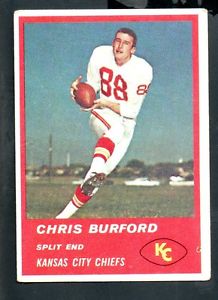
Burford was then also working for the NBC TV affiliate in Kansas City and passed along the final score to the Associated Press. They asked him to correct the score he sent – they didn’t believe it could be 66-24.
Lonnie’s Jukebox: As the 1967 baseball season unfolded, the political world was dominated by the war in Viet Nam and the fight for civil rights. Muhammad Ali was stripped of his boxing title. Thurgood Marshall joined the Supreme Court. It was the year of Sgt. Pepper’s from the Beatles and Dustin Hoffman as The Graduate. Jann Wenner started a new magazine in San Francisco – Rolling Stone. He still owns the magazine, but has put it up for sale.
It was also the Summer of Love, especially in San Francisco (but little love for the Giants who finished far behind the Cardinals). Rita and I were in San Francisco this past June at the end of our California baseball stadium tour, and the city was celebrating the 50th anniversary of the Summer of Love. We went to a museum exhibition filled with nostalgia from that summer, and we also posed for the obligatory photo in a hotel lobby off Union Square:
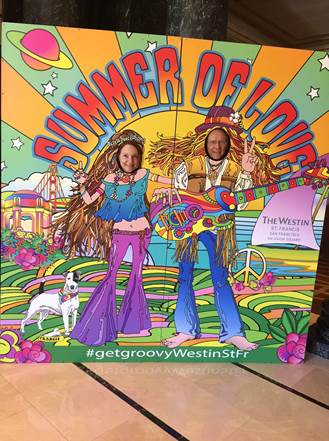
The big concert event in the summer of ‘67 was the Monterey Pop Festival, a precursor to Woodstock to be held two years later. The acts at Monterey included the Grateful Dead, Janis Joplin, Otis Redding, Jimi Hendrix, The Who and Jefferson Airplane. John Phillips of the Mamas and Papas was one of the organizers of the festival and wrote a song for his friend Scott McKenzie to promote the festival. The song perfectly captures the vibes of the Summer of Love. Take a listen: San Francisco (Be Sure to Wear Some Flowers in Your Hair).
Lonnie’s Jukebox – Bonus Cut: Five months after the Monterey Pop Festival, The Who performed at Shawnee Mission South High School in Overland Park, Kansas. As the opening act for The Buckinghams. How could that be? The Who is in the Rock and Roll Hall of Fame. The Buckinghams are the answer to a trivia question. But 50 years ago, it did not look like that. Here’s the story.
At the time of the Monterey event, The Who (an English band) was not yet well known in the U.S. Their only chart hit had been “My Generation” (#74 in the U.S.). Getting into the Monterey concert lineup was a big opportunity, and they took full advantage by playing a resounding set that ended with their signature smashing of guitars and drums (their “auto-destructive art”). Not that it was enough to keep them from getting upstaged. Jimi Hendrix took the stage later that night and ended his act by dousing his guitar with lighter fluid and setting it on fire.
After Monterey, The Who toured the States as the opening act for Herman’s Hermits. When that tour ended, they started a second tour – first stop, Shawnee Mission South. Seriously. By then, The Who had a second chart hit (“I Can See for Miles”), but they were way behind The Buckinghams on the charts. In early 1967, The Buckinghams had gone to #1 with “Kind of a Drag,” followed by four more Top-20 hits that year (“Hey Baby, They’re Playing Our Song”, etc.). They were bigger than The Who. For one year. They never had another big hit. The Who went on to have ten Top-10 albums and the theme songs for all the CSI shows.
I did not know about the 1967 local concert until KC Star sportswriter Rustin Dodd tweeted that fact last month on the 50th anniversary. Dodd attached a KCUR post on the event, and one of the former students interviewed was Hot Stove reader Don Thellman. Don’s first-hand report was that The Who worked just as hard for the hundreds at Shawnee Mission as they had in Monterey. “They didn’t spare anything. They were kicking over the amplifiers…and smashing the guitars on the floor. I would love to have a picture of the audience because I’m sure everybody’s mouths were wide open watching that.” I followed up with Don, and he says he picked up a spring on the floor that he believed came from a drum pedal that went flying as Keith Moon tore up his drum set.
Now back to The Buckinghams. The trivia question that they answer is “Who (not “The Who”) had five Top-20 songs in their career, all of which charted in the same year?”. For the one that went to #1, listen here.
